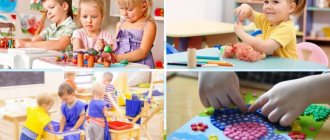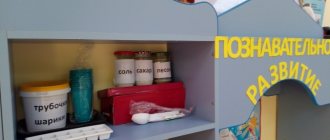Subject environment in the senior group
For the full development of a child as an individual in the senior group of kindergarten, familiarization with the world of adults and objects that are created by their work is of great importance. The exploratory approach that is typical for preschoolers of this age allows them to act more independently and intelligently in everyday life. Helps to develop a moral attitude towards surrounding objects and perceive them as the result of human labor.
The purpose of introduction to the objective world is to form ideas about the subject as a result of human labor, about the creation of human thought.
At the beginning of the school year, certain tasks are set that must be implemented in the senior group:
– Development of preschoolers’ understanding of the world of surrounding objects.
– Getting to know objects that make a person’s work easier in everyday life and create a certain comfort.
– Determination of the materials from which objects are made.
– Comparison and classification of objects according to a certain criterion.
Along with the subject environment, the senior group pays great attention to the social environment. Let's consider some phenomena of social life.
Family.
– Knowing your home address.
– Formation of interest in one’s ancestry.
– Looking at photographs of relatives, finding similarities.
– Introducing children to their parents’ place of work and their profession.
– Correct attitude and respect for the work of all family members.
– Having constant responsibilities around the house.
– Involvement in the preparation of family celebrations and holidays.
Kindergarten.
– Expanding children’s understanding of preschool.
– Ability to navigate the territory of the kindergarten and its premises.
– Involvement in events that take place in kindergarten.
– Participation in the social life of the kindergarten together with parents.
– Familiarity with safety precautions on the street and at home.
– Formation of a respectful attitude towards preschool employees.
– Development of attention and sensitivity to peers and younger preschoolers.
Adult labor.
– Expanding preschoolers’ understanding of various professions.
– Meeting people of certain professions, including modern ones.
– Getting to know the personal and business qualities of people who work.
– Explanations of the significance and importance of human work.
– Disclosure of business and personal qualities, goals and motives of work.
– Developing a sense of gratitude and respect for people for their work.
Home country.
– Expanding the understanding of our country.
– Acquaintance with the customs and traditions of Russia.
– Formation of interest in the native land in which we live.
– Explanation of the multinationality of our country.
– Introduction to state and national holidays.
– Search for our country, some cities, forests and rivers on contour maps.
– Familiarization with the melody of the anthem, flag and coat of arms of Russia.
Our army.
– Introduction to the Russian Army.
– An explanation of the importance of the difficult and honorable duty of defending the Motherland and maintaining its security.
– Inviting military and veterans to the preschool.
– Looking at reproductions of paintings with military themes with the children.
– Education of patriotism among preschool children.
Long-term planning for familiarization with the outside world in the senior group
Tasks:
expand your understanding of the diversity of indoor plants; learn to recognize and correctly name indoor plants; talk about professions related to caring for indoor plants; consolidate knowledge about the basic needs of indoor plants, taking into account their characteristics; improve plant care skills; cultivate a caring attitude towards plants. . (“Acquaintance with nature in kindergarten.” A. Solomennikova p. 66)
4 "Excursion to the Zoo"
Tasks:
expand children’s understanding of the diversity of the animal world, that man is part of nature, and he must preserve, protect and defend it; to form the idea that animals are divided into classes: insects, birds, fish, animals; develop cognitive interest, curiosity, emotional responsiveness. . (“Acquaintance with nature in kindergarten.” A. Solomennikova p. 63)
March
1 “Flowers for Mom”
Tasks:
expand your understanding of the diversity of indoor plants; learn to recognize and correctly name indoor plants; give basic ideas about plant propagation by vegetative means; learn to plant seedlings of indoor plants; to form a caring and attentive attitude towards loved ones, a positive attitude towards work. (“Acquaintance with nature in kindergarten.” A. Solomennikova p. 62)
2 “Water Resources of the Earth”
Tasks:
expand understanding of the diversity of water resources: springs, lakes, rivers, seas; about how a person can use water in his life; about how to use water resources economically; consolidate knowledge about the water resources of their native land; about the benefits of water in the life of humans, animals and plants. (“Acquaintance with nature in kindergarten.” A. Solomennikova p. 69)
3 "Journey into the Past of the Light Bulb"
Tasks:
introduce children to the history of the light bulb, arouse interest in the past of this item. . (“Acquaintance with the subject and social environment” by O.V. Dybin p. 41)
4 “Visiting the artist”
Tasks:
to form ideas about the social significance of the artist’s work and its necessity; show that the products of his work reflect feelings, personal qualities, interests. . (“Acquaintance with the subject and social environment” by O.V. Dybin p. 43)
April
1 "Journey into the Past of the Vacuum Cleaner"
Tasks:
arouse interest in the past of objects; lead to the understanding that a person invents and creates various devices to make work easier. . (“Acquaintance with the subject and social environment” by O.V. Dybin p. 45)
2"Russia is a huge country"
Tasks:
to form the idea that our huge, multinational country is called the Russian Federation (Russia), there are many cities and villages in it; to get from one end of the country to the other, for example from the city of Kaliningrad to the city of Vladivostok, you need to travel by train for several days. Introduce Moscow - the main city, the capital of our Motherland, and its attractions. (“Acquaintance with the subject and social environment” by O.V. Dybin p. 46)
Methods of introducing preschoolers to the objective world
Anzhelika Gulakova
Methods of introducing preschoolers to the objective world
Methods of introducing preschoolers to the objective world
An important place in enriching children's vocabulary is occupied by special classes to familiarize themselves with the objective world . Their main goal is to introduce into children’s speech the names of objects , their parts, some signs, properties and qualities. Children learn to identify the qualities and properties of objects , their purpose, and then generalize them into conceptual groups.
The methodology for these classes was proposed by E. I. Tikheeva and clarified and supplemented by V. I. Loginova. The authors identify 3 groups of classes to familiarize themselves with the subject world :
1- initial familiarization with the subject .
2 - familiarization with the qualities and properties of objects .
3 - formation of concepts in the process of generalizations.
Initial familiarization with objects - introducing new names of objects into the dictionary and actions with them . Conducted in younger and middle ages.
Meaning:
1. A holistic idea of the subject
2. The connection between the purpose of an object , its structure, and material.
Requirements for these classes:
1. Cognitive activity is represented by practical tasks and is based on gaming techniques.
2. Use of visual material according to the number of children.
3. Active actions with objects , children choose suitable ones and motivate the choice.
4. Objects must be known to children.
5. Leadership is provided through instructions and questions.
Lesson structure.
The introductory and final parts are similar to other lessons.
Main part
1. Statement of the educational task ( the formation of differentiated perception is carried out through the game).
2. Examination of the subject , structure, purpose, introduction of words.
3. Children’s choice of subject , consolidation of knowledge, consolidation of words.
In classes to deepen knowledge about the qualities and properties of objects holistic understanding of the object : a connection is established between the purpose of the object and its structure , the material from which it is made, and the specific features of the object are determined .
Meaning:
1. The concept is formed that all things are made of different materials; there are processes that transform material into a thing (sewing, knitting, modeling, woodworking, etc.)
2. The ability to see material in a thing is formed, to establish the properties of the material in some ways (press, bend, tear)
.
Requirements
1. Thorough sensory examination.
2. Visual material on the number of children.
3. Inclusion in activities.
4. The qualities being isolated must be clearly presented .
5. Comparison with other qualities and properties of other objects .
6. The teacher’s guidance is carried out through questions and precise instructions.
Lesson structure
1. The introductory and final parts are similar to other classes.
Main part
1. Isolating qualities in the situation of a particular activity (first indicating the action, then asking the children)
.
2. Teaching research actions to isolate the desired property (first indicate the action, a question of a stating and indirect nature (Strong paper, why)
.
3. An exercise in identifying a new quality and property in a variety of objects - consolidating properties.
Complication - at an older age, these classes become more complicated, they are called “Comparison of objects "
their goal is to select the most accurate word to characterize the highlighted features.
Requirements
1. A sufficient number of compared characteristics (shape, size, color, their differences and commonality.
2. Planned comparison of the whole, parts and details, generalization as a whole.
3. Selection of teaching methods - instructions and questions.
4. Maximum speech activity of children.
Formation of specific and generic concepts in the process of generalization.
Classes are held in all age groups. the same essential features in different objects There are two types of these activities - the formation of specific and generic concepts.
Species concepts are objects of the same type with insignificant differences, for example: chair, stool, armchair.
Lesson structure
The introductory and final parts are similar to other classes.
Main part
1. The need for choice through the game.
2. Selecting an item from a group of similar ones (how did you find out? Why did you take this item and not another? What does this item that others don’t (and vice versa? After each answer - motivation - Why do you think so?
3. Exercise in choosing objects .
Generic concepts - objects of different types , but united by one purpose (dishes, transport, furniture, etc.)
Lesson structure
The introductory and final parts are similar to other classes.
Main part
1. Consideration of 3-4 types, highlighting known features (what is the car for, who drives it)
2. Work on the concept ( definition of an essential feature, generalization of a group of 3-4 types and introduction of the word generalization (we highlight what is the same and what is different for all types and conclude: everything that is used to transport people and cargo is called transport)
3. An exercise in subsuming specific concepts under generic ones.
Subsequent work is based on consolidation and differentiation of concepts.






